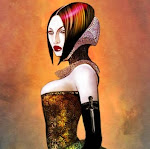The play doesn't need a great deal of technical support. We have played successfully in full daylight with neither sound nor lights and consider we can adapt to whatever is available. However the audience experience is enriched if we have access to even a basic lighting rig and if we have the ability to play music and sfx before, during and after the performances.
The set is minimal, consisting of 3 folding chairs and a couple of step ladders, and so the show is best suited to an intimate studio-style venue or small theatre. This kind of space also best suits the style of the piece.
At C-central in Edinburgh, where it was first produced, the show shared a basic lighting rig with several other productions using the space. The lighting cover consisted of a warm wash and a cold wash, we had the ability to light stage left and stage right independently, and there were three 'specials' that could be re-gelled and refocussed between shows.
At The Bakehouse in Adelaide, the show benefited from a more sophisticated rig and lighting design - full details of which are available - but this was still well within the capabilities of most dedicated theatre spaces.
Regarding sound, one CD player with a speaker system capable of providing good sound distribution in the space is all that's necessary.
The stage area should be at least 4 m x 5 m but it can be in thrust or end-on configuration. It helps sight-lines if the stage area is raised above floor level or if the audience seating is raked. As the actors do not leave the stage after their first entrances, no wing space is necessary.
When working in a shared space - such as in a festival, get in and get out for the show can be accomplished in 10 and 5 minutes respectively, assuming the actors have access to the dressing room for an additional 15 minutes or so before and 5 minutes after the show.
We travel with our own sound/lighting operator/stage manager wherever possible.
Shakespeare's Mothers on YouTube
See the video trailer for the show!

Ilustration: Lady Macbeth by Steve Pugh

Alexander Jonas, Cat Martin, Kath Perry
Contact Us
You can email us at: shakespearesmothers@gmail.com